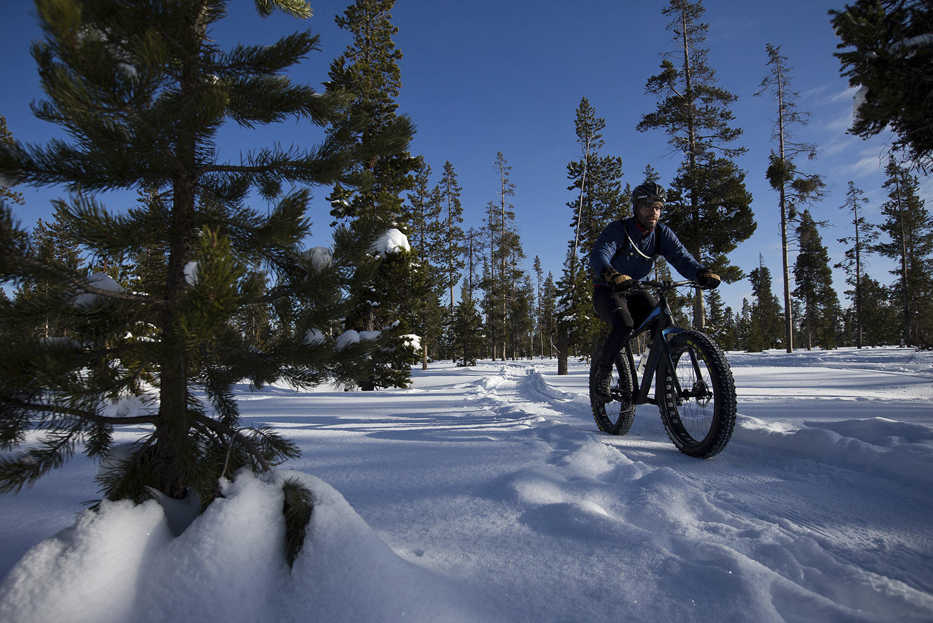BEND, Ore. — For those who just refuse to stop mountain biking, even when most Central Oregon singletrack is covered in snow — fatbikes are an option.
And soon, they will be able to ride those fatbikes on groomed singletrack snow.
Again this winter, Bend’s Gary Meyer will groom singletrack trails for fatbikers at Wanoga Sno-park, where they can ride starting Jan. 1.
He estimates at least 3 feet of snow has accumulated at Wanoga, about 12 miles west of Bend, where he plans to groom trails via a temporary permit with the Deschutes National Forest. The past two winters, Meyer groomed about 9 miles of 2-foot-wide trail (a 3-mile loop and a 6-mile loop), using a snowmobile with a metal roller attached behind.
Meyer, the winter trails steward for the Central Oregon Trail Alliance, says he plans to begin grooming on Monday.
With all the snow on the ground lately in Central Oregon, more and more fatbikers are taking to the streets. Global Fatbike Day was Dec. 3, and numerous groups held outings in Central Oregon to commemorate the occasion.
“There was 35 of us that rode out to Tumalo Falls,” Meyer says. “Then on Facebook I started looking, and I counted at least five other groups that had 20 or more people. There was a group of 25 that took off at Wanoga, another big group at Dutchman Flat Sno-park, another at the Phil’s Trail network. It’s amazing how fast it’s grown. Yeah, you see a few people riding around town, but out on the trails, now it’s big groups of people.”
Some fatbikers are not even waiting for Meyer’s grooming to ride snowy singletrack. Several have been working along singletrack in the Phil’s Trail network west of Bend to pack down the snow on the trails with snowshoes so the trails are ridable on fatbikes.
“There’s people saying, ‘OK, I wanna try to keep this loop in the Phil’s Trail network packed as long as we have snow all winter,’” Meyer says. “As long as you keep riding it, if there’s just a little snow, it’s easy to keep packed. Even though we’re grooming trails, other people are doing man-powered grooming.”
Fatbikes’ wider tires (typically 3.8 inches wide versus 2.25 inches for mountain bike tires) allow for better traction in snow or sand. Central Oregonians primarily use them for riding in the snow.
Tire pressure can be as low as 5 or 6 pounds per square inch on fatbikes — mountain bikes are usually between 30 and 50 psi — to provide even more traction on challenging terrain.
Groomed trails give fatbike riders a firmer surface to avoid sinking into the snow.
Fatbikes are capable of ripping through about 2 to 3 inches of fresh snow. Anything deeper than that becomes extremely difficult, Meyer says.
Fatbikes are also allowed on groomed snowmobile trails in Central Oregon, but they are prohibited at Nordic ski areas such as Virginia Meissner Sno-park and the Mt. Bachelor Nordic Center.
“You can go on the snowmobile trail, you can go on the snowshoe trails, but stay off the ski trails,” Meyer says of fatbikers. “With snowmobile trails, when you hear them coming, get off to the side, because they cannot see you very well. You can hear them way before they’re near you.”
While riding snowmobile trails on fatbikes can be fun, groomed singletrack is much more enjoyable, Meyer notes. It is similar to riding regular dirt singletrack, but on snow.
“A snowmobile trail is like you’re riding down a big, wide street,” Meyer explains. “There’s not the twisty, turny, flowy singletrack experience, and that’s the biggest difference.
It’s equivalent to riding your bike on a forest road in the summer, versus riding your bike on dirt singletrack. It gives you more of that flying-through-the-forest feel.”
For Meyer and many other mountain bikers in Central Oregon, fatbiking on snowy singletrack provides a chance to truly make their sport a year-round activity, even when snow blankets the entire region.
And fatbiking is an even better workout than mountain biking.
“For me, I just like riding bikes so much that it’s hard to give up riding bikes in the winter,” Meyer says. “It’s a good workout. If I go on a 12-mile fatbike ride, I equate it more to a 24-mile dirt mountain bike ride. It’s about double.”

